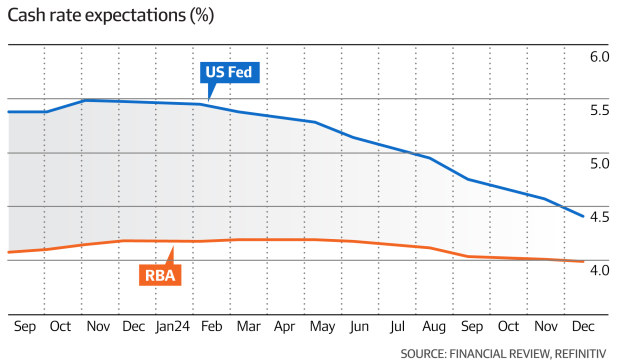Lacklustre China stimulus lifts the Australian dollar

The Australian dollar moved higher on Monday, rebounding from nine-month lows as China announced a series of small stimulus measures to boost it ailing economy.
The local currency rose to US64.27¢ on Monday after it last week finished flat, halting five straight weeks of losses. It touched a nine-month low of US63.63¢ mid-August, dragged lower by China’s deteriorating economic outlook and the interest rate differentials between the US and Australia.
On Sunday, Beijing announced it would halve the stamp duty on stock trading in its latest attempt to boost the struggling equity market. That followed Friday’s announcement about planning the construction of affordable housing.
“These steps are all positive for risk assets, like the Australian dollar, equities, copper, and iron-ore prices, which all ended higher last week,” said Prashant Newnaha, a senior macro strategist at TD Securities. “The real question is can the market hang on to these gains.”
While the Canadian broker has forecast the Aussie dollar to jump 4 per cent to US67.4¢ by late October, investors are losing patience with what they see as slow and stingy measures by China to defuse a deepening property crisis.
On Monday, shares in the world’s most-indebted property developer China Evergrande Group plunged 87 per cent as it resumed trading in Hong Kong following a 17-month trading halt. Evergrande is at the centre of the property crisis that has seen a string of debt defaults since late 2021.
Modest interest rate cuts and vague promises of support by Beijing for debt-mired property developers have failed to restore investor sentiment. China’s CSI300 index of blue-chip stocks has shaved off 9 per cent since August 11 as foreigners yanked 78 billion yuan ($16.7 billion), in their longest selling streak since 2015, according to Reuters.
Elsewhere, the much-anticipated speech by the US Federal Reserve chairman Jerome Powell at Jackson Hole failed to give investors much clarity on the next interest rate move for the world’s largest economy. He also stuck to his “high rates for longer” rate message.

Interest rate futures tied to the Fed’s policy rate slightly increased the chances of tightening at both the November and December central bank policy meetings after Mr Powell’s speech. They give an 80 per cent chance it will stand pat next month at 5.37 per cent.
“In the end ... Powell did not break significant new ground in the Fed’s ongoing fight against inflation,” said Stephen Wu, an economist at the Commonwealth Bank. “He retained policy flexibility.”
Addressing the central banking symposium, Mr Powell said the Fed could raise rates again if the data supported that view. But he noted that with inflation moving lower, the central bank had the option of holding policy at its current level for an extended period.
Fed fund futures ascribe a 63 per cent chance of a US rate rise this year, while in Australia, interbank futures imply just a 3 per cent chance that Reserve Bank will lift the cash rate next week to 4.35 per cent.
The difference between the two cash rates has weighed on the Australian dollar. Financial markets are pricing in a 47 per cent chance that the RBA will lift the cash rate by March next year and ascribe a small chance of a rate cut from late 2024.
In other words, investors are unconvinced that higher borrowing costs are needed to repel inflation. Instead, they wager that the cash rate will stay at 4.1 per cent for the next six months.
A better-than-expected global economy has also led investors to push back the timing of the start of rate cuts. Australian retail sales bounced 0.5 per cent in July, after a surprise fall the previous month. While the data beat forecasts for a 0.3 per cent gain, it’s unlikely to affect monetary policy.
“While there was a rise in July, underlying growth in retail turnover remained subdued,” said Ben Dorber, ABS head of retail statistics.
Australian bond yields tracked higher, with the three-year rate three basis points higher to 3.87 per cent and the 10-year up one basis point to 4.15 per ent.
US bond yields rose with the return on US 10-year Treasuries up to 4.25 per cent, pulling close to a 10-year peak of 4.37 per cent last week. The two-year yield, which reflects interest rate expectations, edged up to 5.09 per cent.
Introducing your Newsfeed
Follow the topics, people and companies that matter to you.
Find out moreRead More
Latest In Currencies
Fetching latest articles